High Fidelity Cable Magnetic Wave Guide AC Conditioner
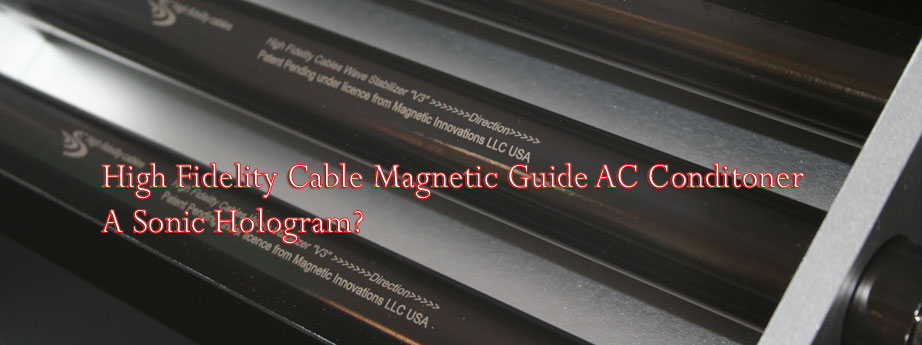

 I think my quest for realism in music reproduction, if achieved, requires many obvious components and many not so obvious components. It used to be that one had a music source, a preamp/phono stage, a stereo amplifier, and of course, speakers. Interconnects, speaker wires, and power cords either came with components or were bought at Radio Shack. Now, however, cables, power cords, isolation devices, AC filtering, even ones household electrical system, such as wall outlets, circuit boxes, and earth grounding, may – and mainly do – shape the realism of what you hear.
I think my quest for realism in music reproduction, if achieved, requires many obvious components and many not so obvious components. It used to be that one had a music source, a preamp/phono stage, a stereo amplifier, and of course, speakers. Interconnects, speaker wires, and power cords either came with components or were bought at Radio Shack. Now, however, cables, power cords, isolation devices, AC filtering, even ones household electrical system, such as wall outlets, circuit boxes, and earth grounding, may – and mainly do – shape the realism of what you hear.
I think what we seek is the sonic counterpart to a visual hologram. A good hologram would make the person seemingly present. Realism in audio would be to have the music performers physically present to our ears. This would need to have depth, height, width, precision in location, and tumbrel accuracy. This is a review of an electrical filtering device that conditions the AC available to components that is superior to what it was coming out of the wall. The High Fidelity’s Magnetic Wave Guide power filter does achieve a sonic equivalent to a hologram in my system. It has lots of help, but it goes where no other filter has ever gone for me. It rivals, if not surpasses the impact of the High Fidelity magnetic conduction interconnects and speaker wires that use the same technology.
Several notable helpers are the Tripoint Troy Signature grounding device, especially with the new Troy SE grounding cable, the Exemplar eXpo T 105 (an Oppo BDP-105 modification), the BMC PureDac, and the High Fidelity Ultimate and at the very end, Ultimate Reference cables, but it greatly surpasses other AC filters in that same system, including an early prototype of High Fidelity filter.
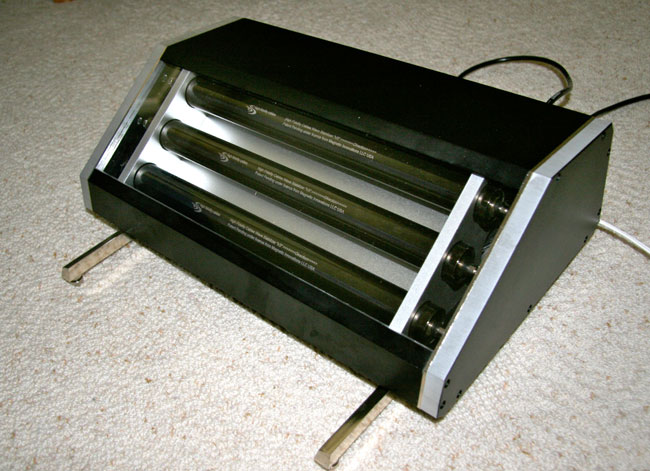
Magnetics are once again the central feature of this AC filter. It has the Ultimate Reference level waveguides on the three power cord conductors. These are in a carefully designed box that looks much like a toaster oven. It seeks to minimize vibrations and to shunt them to earth ground, but more importantly is the removal of noise from transformers, RFI, and EMI coming in from your AC source. I sought an answer to how this is works. Not surprisingly the answer I was given is that the magnets somehow stop the vibrations of the transformer from affecting the signal.
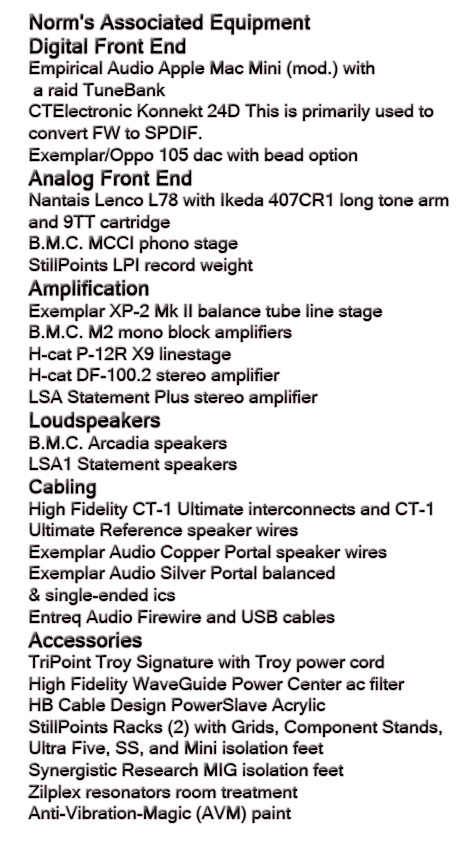
I do know that what they seek is an improvement in the sound of components fed by the AC through the filter. In other words the filter improves the performance of the component. When I asked whether this can be measured in differences in the AC before and after the filter, I was told that it was measurable in distortion measures of the component’s signal.
Setup
My system has settled down somewhat. The key elements are the Exemplar XP-2 using single-end High Fidelity cabling to the BMC M2 amps, which in turn, drive the BMC Arcadia speakers. The power cords are all Exemplar Portals, and the cables are all High Fidelity Ultimates except for the prototype Ultimate Reference speaker wires. In the later stages of the review, all cables were the HFC Ultimate Reference cables. The sources are the Exemplar eXpo T105 (Oppo 105 based) used both as a player and as a dac, the BMC PureDac, and a Nantais Lenco Reference with Ikeda 407CR1 “long” arm and 9TT cartridge. Vibration isolation is StillPoints Racks with Grids, Component Stands, Ultra Minis, Ultra SSs, and Ultra Fives.
Shortly after I was confident that the filter was broken in, one of the BMC M2 amps failed. I installed my LSA Statement integrated amplifier with its Urushi caps. I used only the amplifier section. Also, I got Star Sound Technology Sistrum Apprentice platforms first under my speaker’s’ external crossovers and later under the LSA and speakers finally. And the last change was the introduction of a High Fidelity Ultimate Reference interconnects and speaker wires loom, as I mentioned.
The High Fidelity was on and in use for nearly two weeks before I heard a big jump in the system’s realism. Even now at over a month’s worth of break in, I have heard subtle improvements with occasional jumps. I think that this has finished. I say this after just hearing a major jump in realism last weekend.
Listening Sessions
The first thing that one notices with this AC filter, is now much the noise floor drops, but shortly thereafter one notices the speed or the sharpness of the leading edge. Anything that had horns, drums, or piano in it sounded wrong without the HF Magnetic Waveguide power filter. This was very much like the experience of putting the original High Fidelity CT-1s in, resulting in a sweet and easy top end. But what is most revolutionary about the filter is the large number of recordings that shock you with their openness in all directions and the strong involvement one feels in “being there” at the recording sessions. I find this thrilling and something that I never expected to achieve in music reproduction. I find that like at a live music performance, I have to listen and not engage in other activities.
One example of this is the Rob Wasserman’s Duets (MCA Audiophile MCAD-42131) disc. Every cut suggests either a different mic’ing or studio and most have a very large and involving sound stages. In particular, Stephane Grappelli’s violin performance in “Over the Rainbow’ and Cheryl Bentyne’s “Angel Eyes,” are exemplary.
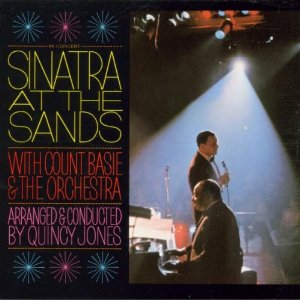 Anyone who reads my reviews would know I have certain reference music cuts. I often start with the Basie big band on Sinatra at the Sands album (Sinatra At The Sands Vicy (94366 Japan) SHM). There is an audience and a big orchestra, plus Sinatra and Basie present. I particularly like the piece “One for My Baby and One More for the Road.” With the MWGPF (Magnetic Wave Guide Power Filter) the soundstage was more open and defined than with my reference unit. One could hear the piano of Basie to the left of Sinatra as well as the audience behind Basie. I have a little trouble visualizing where I am in this room. Starting at the left is some of the audience and they are present even behind Sinatra. To my right the large Basie band sits and occasionally bursts into playing.
Anyone who reads my reviews would know I have certain reference music cuts. I often start with the Basie big band on Sinatra at the Sands album (Sinatra At The Sands Vicy (94366 Japan) SHM). There is an audience and a big orchestra, plus Sinatra and Basie present. I particularly like the piece “One for My Baby and One More for the Road.” With the MWGPF (Magnetic Wave Guide Power Filter) the soundstage was more open and defined than with my reference unit. One could hear the piano of Basie to the left of Sinatra as well as the audience behind Basie. I have a little trouble visualizing where I am in this room. Starting at the left is some of the audience and they are present even behind Sinatra. To my right the large Basie band sits and occasionally bursts into playing.
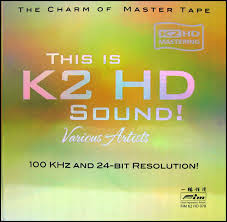 Amerset Swan Lake Duo selection on the K2 sampler “This Is K2 HD Sound” (UD! FIM (K2 HD 078)), again lends an openness and clarity to the music. Here the perfection of this performance and recording are thrilling. The harp is quite real sounding, the double basses being plucked quite audible, and the noises of the musicians lends realism to the recording.
Amerset Swan Lake Duo selection on the K2 sampler “This Is K2 HD Sound” (UD! FIM (K2 HD 078)), again lends an openness and clarity to the music. Here the perfection of this performance and recording are thrilling. The harp is quite real sounding, the double basses being plucked quite audible, and the noises of the musicians lends realism to the recording.
On Willie Nelson and Marsalis (Willie Nelson and Wynton Marsalis “Two Men With The Blues” Blue Note Records (TOCP-70541 Japan), the Stardust cut highlights both Walter Blanding on the Sax and Wynton Marsalis on the trumpet. Here the trumpet is perfectly captured. Willie Nelson singing is very realistic. All in all it makes me wish I could have been present for the concert.
Rickie Lee Jones’ “Pop Pop” Geffen (Gef 24426) throughout the album is strikingly present. I love Dat Dere, I Won’t Grow Up, and I’ll Be Seeing You. I would have loved to be there at the recording, but this is damn close to that.
Finally, there is Paul Simon’s “Songwriter” Sony Legacy (B005KLNOLA) The first cut is The Sound of Silence done in Webster Hall live. He is alone with his guitar. This is the most real sounding cut of the album, including all the young men making asses of themselves by whopping and yelling out.
Conclusion
On many recordings one senses the broad expanse of the recording venue with the High Fidelity Magnetic Waveguide Power Filer. You almost sense that you are there. The noise level drops dramatically revealing information that heretofore I had not heard, and the leading edge is so sharp that brass, drums, and pianos now sound quite real.
I once counted 27 various types AC filtering devices that I have tried, starting with a Graybar isolation transformer. The original question was whether one heard any improvement and then whether it was dynamic or not. With the High Fidelity Magnetic Waveguide power filter, my issue is how did I ever do without it. I will not be without it any longer.

norm luttbeg

Specifications:
Price: $16,900
High Fidelity Cables
Telephone number: 1-972-312-1902
Website: http://www.highfidelitycables.com
Stereo Times Masthead
Publisher/Founder
Clement Perry
Editor
Dave Thomas
Senior Editors
Frank Alles, Mike Girardi, Key Kim, Russell Lichter, Terry London, Moreno Mitchell, Paul Szabady, Bill Wells, Mike Wright, Stephen Yan, and Rob Dockery
Current Contributors
David Abramson, Tim Barrall, Dave Allison, Ron Cook, Lewis Dardick, Dan Secula, Don Shaulis, Greg Simmons, Eric Teh, Greg Voth, Richard Willie, Ed Van Winkle, and Rob Dockery
Music Reviewers:
Carlos Sanchez, John Jonczyk, John Sprung and Russell Lichter
Site Management Clement Perry
Ad Designer: Martin Perry





Be the first to comment on: High Fidelity Cable Magnetic Wave Guide AC Conditioner